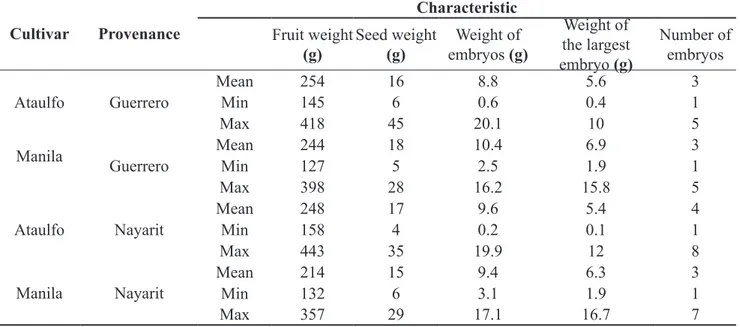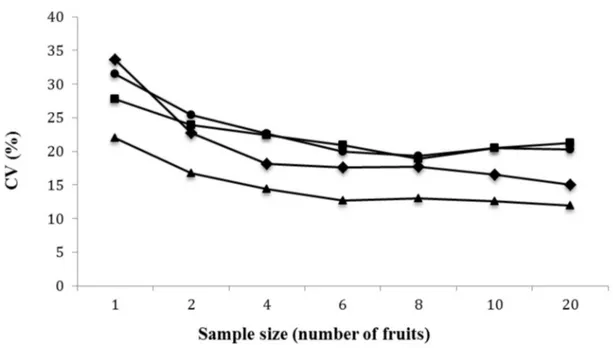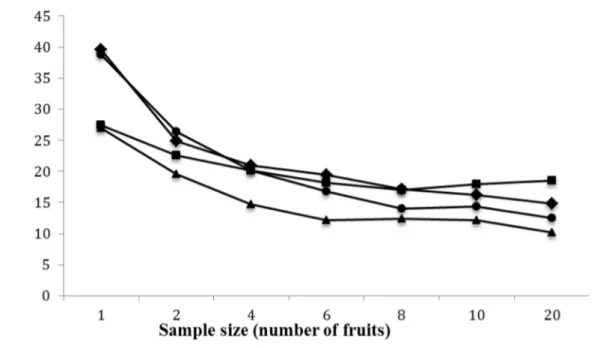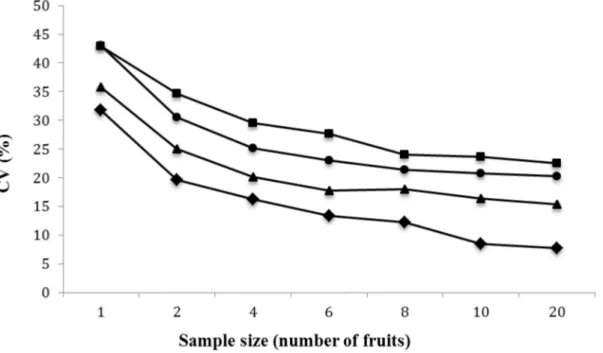1
Corresponding author: villema53@hotmail.com
Received: May 08, 2017.
Accepted: November, 14, 2017.
Copyright: All the contents of this journal, except where otherwise noted, is licensed under a Creative Commons Attribution License.
Optimum sample size in quantitative characteristics
of seeds of polyembryonic mango
Nely Arellano-Durán
1, Ángel Villegas-Monter
2, Abel Muñoz-Orozco
31Ph.D in Genetics. Student PREGEP-Genética Campus Montecillo, Colegio de Postgraduados Km 36.5 carretera México-Texcoco, CP. 56230, Texcoco, Edo. de México. México. E-mail: arellano_nely@yahoo.com.mx
2Ph.D in Fruticulture. Professor Researcher PREGEP-Fisiología, Campus Montecillo, Colegio de Postgraduados Km 36.5 carretera México-Texcoco, CP. 56230, México-Texcoco, Edo. de México. México. E-mail: villema53@hotmail.com
3Ph.D. in Genetics. Professor Researcher PREGEP-Genética Campus Montecillo, Colegio de Postgraduados Km 36.5 carretera México-Texcoco, CP. 56230, México-Texcoco, Edo. de México. México. E:mail:amunozo@colpos.mx
Abstract - Determining the sample size in a scientific investigation is important because it gives
reliability in the results together with the efficiency in the use of resources and optimization of time.
Polyembryony is a characteristic that allows to obtaining clonal and zygotic plants in the same seed. In mango this characteristic is presented, however, there is no information that mentions which is the adequate sample size to evaluate it. The objective of the present work was to determine the optimum sample size by means of the maximum curvature method for future polyembryony studies. Mangoes from the cultivar Manila and Ataulfo were collected from the states of Guerrero and Nayarit, Mexico. In each state, two orchards of each cultivar were chosen, and in each one three trees were selected.
In the Fruit Biotechnology laboratory of the Colegio de Postgraduados, Campus Montecillo, five
fruit variables were evaluated: weight of fruit, seeds (endocarp and embryos), embryos, weight of the largest embryo and number of embryos. In all the variables evaluated, except for the weight of
the largest embryo, the inflection point of the curve was in 6 fruits and an optimal sample size of 8 fruits was determined. The minimum variation coefficients (CV) for fruit weight were from 17.9 to
19.1%, for seed weight 12.7 to 19.3%, embryo weight 12.3 to 17.1% and number of embryos 6.7 to 16.7%. In the case of larger embryo weight, it was determined that 20 fruits are the optimal sample size, obtaining CV from 7 to 22.6%. The fruit and seed weight characteristics were the least variation, and number of embryos with higher CV. The cultivar Manila of Nayarit presented the highest CV in all the variables studied.
Index terms:Mangifera indica, maximum curvature method, coefficient of variation
Tamaño de muestra óptimo en características
cuantitativas de semillas de mango poliembriónico
Resumen - Determinar el tamaño de muestra en una investigación científica es importante ya que da
confiabilidad en los resultados aunado a la eficiencia en el uso de los recursos y optimización de tiempo.
La poliembrionía es una característica que permite obtener plantas clonales y cigóticas en la misma semilla. En mango se presenta dicha característica, sin embargo, no existe información que mencione cual es el tamaño de muestra adecuado para evaluarla. El objetivo del presente trabajo fue determinar mediante el método de curvatura máxima el tamaño de muestra óptimo para estudios futuros de poliembrionía. Se colectaron mangos del cultivar Manila y Ataulfo de los estados de Guerrero y Nayarit, México. En cada estado se escogieron dos huertas de cada cultivar, y en cada una se seleccionaron tres árboles. En el laboratorio de Biotecnología de Frutales del Colegio de Postgraduados, Campus Montecillo, se evaluaron cinco variables de fruto: peso de fruto, semillas (endocarpio y embriones), embriones, peso del embrión más grande y número de embriones. En todas las variables evaluadas a
excepción de peso del embrión de mayor tamaño el punto de inflexión de la curva fue en 6 frutos y se determinó un tamaño de muestra óptimo de 8 frutos. Los coeficientes de variación (CV) mínimos para
peso de fruto fueron de 17.9 a 19.1%, para peso de semilla 12.7 a 19.3%, peso de embriones 12.3 a 17.1% y número de embriones 6.7 a 16.7%. En el caso de peso de embrión de mayor tamaño se determinó que 20 frutos son el tamaño óptimo de muestra obteniendo CV de 7 a 22.6%. Las características peso de fruto y semilla fueron las de menor variación, y número embriones de mayor CV. El cultivar Manila de Nayarit presentó los CV más altos en todas las variables estudiadas.
Introduction
Mango is an important crop in Mexico and the world because of its nutritional qualities and its organoleptic characteristics (SIAP, 2016). In 2016, production was 1.9 tons, highlighting Guerrero, Sinaloa, Nayarit and Chiapas (SIAP, 2016). The mango fruits can be classified according to the type of seeds in monoembryonic, where the seed has an embryo and polyembryonic, where the seeds have more than one embryo. Polyembryony is a type of apomixis (apo = without mixis = mixture) (QUERO CARRILLO et al., 2010), in this case of facultative type in which several embryos of nucellar origin and a sexual embryo in a seed are developed simultaneously (BARCACCIA;ALBERTINI, 2013; KUNDAN et al., 2012). Its importance lies in the fact that it can be considered as a form of vegetative propagation or clonal propagation (BARCACCIA;ALBERTINI, 2013). Plants obtained from polyembryonic seeds are usually used in commercial plantations as rootstocks to guarantee the uniformity of the orchards (CORDEIRO et al., 2006). It is also important because when the sexual embryo germinate generate genetic diversity (GÁLVEZ-LÓPEZ et al., 2010b).
Bandeira et al. (2016) mention that the sample size is proportional to the variability of the data and the desired reliability, being inversely proportional to the a priori error allowed by the researcher. Vallejo and Mendoza (1992) point out that an optimum parcel size depends on the nature of the experimental material, the design of the experiment, the number of repetitions and the available resources. On the other hand, Miranda et al. (2007) mention that the biggest problem when working with fruit trees is to obtain truly random samples when collecting fruits from trees.
By defining the optimal sample size, it is possible to reduce costs in both human and financial resources, in addition to the optimization of time (LORENTZ, 2004, SANTOS et al., 2015), it also becomes essential to make good use of the available space, in many occasions it is usually reduced (VALLEJO; MENDOZA, 1992). Another important issue is that sometimes you have valuable plant material that does not have a vast stock so we must optimize the management, since misuse would cause irreparable losses if you do not have copies elsewhere (SANTOS et al., 2015).
In apple they evaluated size and coloration of fruit of 5 to 30 samples per tree, the authors mention that in these trees the sampling has been based on the models of spatial distribution of branches and buds within the tree; however, in practice the sources of weight variation, fruit coloring, interaction with other trees and the age of the wood or position of the fruit should be considered and has not been successfully integrated into the sampling methods (MIRANDA et al., 2007).
Similarly, in avocado they determined the sample size in order to have a reliable size in the evaluation of xylem characteristics that are directly related to the efficiency of water transport, sap flow and hydraulic conductivity with the specific purpose of selecting those more efficient genotypes (MEZA-CASTILLO et al., 2010).
In the case of polyembryony, a work was found in citrus fruits where they defined the optimum sample size for 15 rootstocks including lemons and hybrids, observing that depending on the rootstock, the optimum number of 9 fruits and 10 to 23 seeds varied (SANTOS et al., 2015). There are several procedures for obtaining the sample size, where we can mention the Maximum Curve Method (SMITH, 1938) for which a blank test is previously carried out which consists of a relatively large plot, either surface, application of agrochemicals or quantity of harvested fruit which is then subdivided into small plots or basic units and several groups are formed according to the researcher. For each variable evaluated (dependent variable) the Coefficient of Variation (CV) is calculated with the different sample sizes and is associated in a scatter plot by placing the size of experimental units (sample size) on the “X” axis and on the axis of the “Y” the CV. In the graph, the maximum curvature point is located by visual inspection which corresponds to the optimum plot size, and it will be the turning point of the curve. The majority of researchers have chosen to choose a sample size where an asymptotic tendency begins to manifest itself to have greater reliability (VARGAS; NAVARRO, 2014; SÁNCHEZ et al., 2006).
With the purpose of being able to make a reliable study to evaluate polyembryony in mango Manila and Ataulfo, it is proposed to define the optimum sample size by means of the Maximum Curvature method.
Materials and Methods
24 h in order to remove the cover and the embryos were weighed. The number of embryos and the weight of the larger embryo were then separated and counted. A fruit was taken as a unit sample (basic unit), then sample sizes of 2 were formed, adding 2 in 2 fruit data, of 4 (adding fruit data of 4 in 4) and thus for 6, 8, 10 and 20 fruits, in order to progressively increase the sample size. To each series of data of different sample size, the Variation Coefficient (CV = S/X 100) was determined. The data was plotted by placing the sample size (number of fruits) on the axis of the abscissae (X) and the percentage CV in the axis of the ordinates (Y). Visually, the inflection point of the curve was determined for each variable and the optimum sample size was defined where the curve becomes asymptotic.
Results and Discussion
The fruits of greater weight were Ataulfo from both places of origin (254g in Guerrero and 248g in Nayarit). While Manila de Guerrero had the largest seeds (18g) on average, the embryo weight was higher, as was the weight of the larger embryo (10.4 and 6.9g respectively). And both the cultivars Manila and Ataulfo of Nayarit had a higher number of embryos (Table 1). The weight of cultivar Ataulfo is in the range reported by Gálvez-López et al. (2010a) in Ataulfo cultured of Chiapas.
Table 1. Mean, maximum and minimum data of the variables evaluated for each mango cultivar of different origin.
Cultivar Provenance Characteristic Fruit weight (g) Seed weight (g) Weight of embryos (g)
Weight of the largest embryo (g)
Number of embryos
Ataulfo Guerrero
Mean 254 16 8.8 5.6 3
Min 145 6 0.6 0.4 1
Max 418 45 20.1 10 5
Manila
Guerrero
Mean 244 18 10.4 6.9 3
Min 127 5 2.5 1.9 1
Max 398 28 16.2 15.8 5
Ataulfo Nayarit
Mean 248 17 9.6 5.4 4
Min 158 4 0.2 0.1 1
Max 443 35 19.9 12 8
Manila Nayarit
Mean 214 15 9.4 6.3 3
Min 132 6 3.1 1.9 1
Max 357 29 17.1 16.7 7
The variable fruit weight showed CV between 13 and 24.5% (Figure 1) which could be said to be an intermediate coefficient (TOEBE et al., 2012). The trend was similar for all the evaluated cases, showing the lowest CV with a sample size between 6 (where the inflection point of the curve is perceived) and 8 fruits (CV from 17.9 to 19.1%), except for the cultivar Ataulfo from Nayarit that with a sample size of 20 his CV decreased to 13.5%; however, for practical purposes it can be said that if a sample size of 8 is chosen it is sufficient to have reliability in the data. Likewise, it is observed that cultivars Ataulfo and Manila from Guerrero together with Manila from Nayarit had a very similar behavior regarding their CV with higher values in all sample sizes compared to Ataulfo from Nayarit that showed in a general way the CV is lower.
In the case of seed weight, coefficients of variation were observed in a range of 11.9 to 33.6% (Figure 2). All the cultivars showed a similar behavior in the different sample sizes. The inflection point of the curve was a sample size of 6 and it became asymptotic with 8 fruits, with coefficients of variation of 12.7% in the case of Manila from Guerrero, 17.6% in Ataulfo from Guerrero, 18.9% for Manila Nayarit and 19.3% in Ataulfo from Guerrero. The cultivars of Guerrero were the ones that showed the lowest CV in all sample sizes.
Number of embryos had CV from 6.7 to 43% in the sample sizes studied. The inflection point of the curve is observed in a sample size of 6 fruits. The cultivar Manila of Nayarit was the one that presented the highest coefficients of variation for this characteristic, while the cultivars of Guerrero and Ataulfo from Nayarit had very close values of CV. According to the values where the curve is asymptotic we can define the best sample size in 8 fruits (Figure 4).
The weight of the larger embryo shows a point of inflection in a sample size 10, different from the rest of the variables evaluated, and becomes asymptotic in 20 (Figure 5). The coefficients of variation in sample size of 20 fruits were 7.7, 15.4, 20.3 and 22.6% for Ataulfo and Manila de Guerrero and Ataulfo and Manila from Nayarit respectively. Cultivars from Guerrero (Manila and Ataulfo) showed lower CV in all sample sizes compared to Nayarit cultivars.
It can be summarized that in the evaluated variables the inflection point of the curve coincides with a sample size of 6 and then the curve becomes asymptotic in 8 fruits with the exception of the variable weight of the larger embryo that had a point in inflection of the curve in 10 and becomes asymptotic in 20 fruits.
Likewise, it was observed that fruit and seed weight have lower CV, however there are differences between the same cultivars of different origin and this variation may be due to the response product of the genotype environment interaction (ANDRADE-RODRÍGUEZ et al., 2005; and the wide morphological and genetic diversity in mango fruits due to free sexual recombination (GÁLVEZ-LÓPEZ et al., 2010b)
While number of embryos had the highest coefficients of variation, which makes sense since the number of embryos between cultivars is different (Manila and Ataulfo) due to genetic diversity and within the same fruits which may be attributable to the state of the plant as well as the soil-climatic conditions; on the other hand, in citrus, Soares Filho et al. (2000), mentions that it can also be affected by the type of pollinator, the amount and viability of pollen, which is variable between places of production as well as between years, so this characteristic tends to be more fluctuating. On the other hand, it has also been seen that those counting variables do not adjust completely to normal, therefore they tend to have high CVs.
Regarding the behavior of each cultivar and its place of origin, it was observed that Manila from Nayarit for all cases was the material that showed the highest CV, that is, presented greater variability, while Manila from Guerrero only showed high CV in weight of fruit, in the rest of the variables remained with low CV similar to the rest of the materials evaluated. In the case of the cultivar Ataulfo from Nayarit had the lowest CV in the variables fruit weight and number of embryos, and Ataulfo from
Guerrero the lowest CV for the weight of the largest embryo.
In similar works to determine sample size, CVs of 22.3 to 32% are reported in the case of peach for pulp firmness, which qualify as high variability and from 12.16 to 14.71% for the characteristic acidity considered intermediate (TOEBE et al., 2012). In this way it is observed that those obtained in mango with 8 samples are close to those reported in other works. Likewise, in relation to the appearance of high CVs, we can argue that for mango if the sample increases too much, it can lead to the appearance of atypical fruits that could also be reflected in the higher CVs.
Previous works focused on polyembryony mainly in fruit trees (citrus and mango) have used different sample sizes for their study. In citrus, specifically Citrus resnhi used 25 seeds to evaluate polyembryony by molecular markers RAPD (ANDRADE-RODRÍGUEZ et al., 2005) similar case in C. volkameriana with the same number of seeds (ANDRADE-RODRÍGUEZ et al., 2004). Martínez-Ochoa et al. (2012) evaluated 100 fruits of Manila and 100 of Ataulfo to obtain the rate of polyembryony and 20 seeds to detect if the obtained seedlings cultured in vitro were of zygotic or nucellar origin. While Cordeiro et al. (2006) used 9 seeds of the cultivar ‘Rosinha’ and 36 seedlings obtained from them for molecular analysis by using RAPD in the detection of zygotic or nucellar origin. The foregoing shows the variation in the amount of material used for each investigation due to not defining the sample size.
Figure 1. Coefficient of variation in relation to the sample size for fruit weight.
Figure 3. Coefficient of variation in relation to the sample size for weight of embryos.
Conclusions
1- The maximum curvature method shows reduction in the coefficient of variation in all variables with an optimal sample size of 8, with the exception of the larger embryo weight.
2- The variables weight of fruit and weight of seed are the characteristics that presented lower coefficient of variation.
3- In mango cultivars Manila and Ataulfo with 8 fruits and 8 seeds are enough to estimate polyembryony rate.
4- The optimal sample for larger embryo weight are 20 fruits.
Figure 5- Coefficient of variation in relation to the sample size for weight of the largest embryo.
References
ANDRADE-RODRÍGUEZ, M.; VI
LLEGAS-MONTER, A.; CARRILLO-CASTAÑEDA, G.; GARCÍA-VELÁZQUEZ, A. Polyembryony and identification of Volkamerian lemon zygotic and nucellar seedlings using RAPD. Pesquisa Agropecuária Brasileira, Brasilia, DF, v.39, p.551-559, 2004. (1)
ANDRADE-RODRÍGUEZ, M.; VILLEGAS-MONTER, A.; GUTIÉRREZ-ESPINOZA, A.; CARRILLO-CASTAÑEDA, G.; GARCÍA-VELÁZQUEZ, A. Polyembryony and RAPD markers for identification of zygotic and nucellar seedlings in Citrus. Agrociencia, México, v.39, p.371-383, 2005. (1)
BANDEIRA, C.T.; S. K. G. FORTES; M. TOEBE; L. SAIFERT; C. L. GIACOBBO and L. J. WELTER. Sample size for estimate the averange of Passiflora caerulea fruits traits. Ciência Rural, Santa Maria, v.46 n.10, p.1729-1736, 2016. (1)
BARCACCIA, G.; ALBERTINI, E. Apomixis in plant reproduction: a novel perspective on an old dilemma. Plant Reproduction, Berlin, v.26 n.3, p.159-179, 2013.
CORDEIRO, M.C.R.; PINTO, A.C.Q.; RAMOS, V.H.V.; FALEIRO, F.G.; FRAGA, L.M.S. Identificação da origem genética de plântulas em sementes poliembriônicas de mangueira (Mangifera indica L.) cv. Rosinha por meio de marcadores RAPD. Revista Brasileira de Fruticultura, Jaboticabal, v.28, n.3, p.454-457, 2006. (1)
GÁLVEZ-LÓPEZ, D.; SALVADOR-FIGUEROA, M.; BECERRA-LEOR, E. N.; GONZÁLEZ-PAZ, M.; HERNÁNDEZ-DELGADO, S.; MAYEK-PÉREZ, N. Molecular diversity and genetic relationships of mango germplasm from Chiapas, México. Agrociencia, México, v.44, p.907-915, 2010b. (1)
KUNDAN, K., MONIKA N., RINCHEN D., BONIFACE L. Y B. PANDEY. Polyembryony and seedling emergence traits in apomictic citrus. Scientia Horticulturae, Amsterdam, v.138, p.101-107, 2012. (1)
LORENTZ, L.H.L.; A.D. LÚCIO; L. STORCK; S.J. LOPES; A.A. BOLIGON; CARPES, R.H. Variação temporal do tamanho de amostra para experimentos em estufa plástica Ciencia Rural, Santa Maria, v. 34, n.4, p. 1043-1049, 2004. (1)
MARTÍNEZ-OCHOA E. DEL. C.; ANDRADE-RODRÍGUEZ, M.; ROCANDIO, R. M.; VILLEGAS, M.A. Identification of zigotic and nucellar seedlings in polyembryonyic mango cultivars. Pesquisa Agropecuaria Brasileira, Brasília, DF, v. 47, n.11, p.1629-1636, 2012. 1)
MEZA-CASTILLO, E.; BARRIENTOS-PRIEGO, A.F.; RODRÍGUEZ-PÉREZ, J.E.; REYES-SANTAMARIA, M.I. Determinación del tamaño de muestra de características del xilema de bote de aguacate mediante remuestreo. Pesquisa Agropecuaria Brasileira, Brasília, DF, v.45, n.12, p.1531-1535, 2010. (1)
MIRANDA, C.; T. GIRARD; P.E. LAURI. Random simple estimates of tree mean for fruit size and color in Apple. Scientia Horticulturae, Amsterdam,v.112, p.33-41, 2007. (1)
QUERO CARRILLO, A.R.; ENRIQUEZ. QUIROZ, J.F.; MORALES-NIETO, C.R. y L. MIRANDA-JIMENEZ. Apomixis y su importancia en la selección y mejoramiento de gramíneas forrajeras tropicales. Revista Mexicana de Ciencias Pecuarias,México, v.1, n.1, p. 25-42, 2010. (1)
SÁNCHEZ, H. M. A., A. MEJÍA C., C. VILLANUEVA V, J. SAHAGÚN C., C. SÁNCHEZ H. Y MA. C. JIMÉNEZ R. Determinación del tamaño adecuado de parcela experimental en calabaza pipiana (Cucurbita argyrosperma Huber var. Stenosperma).Revista Fitotecnia Mexicana, México,v.29, n.4, p.339 -348, 2006. (1)
SANTOS, C.Q. De J.; GIRARDI, E.A.; VIEIRA, E.L.; LEDO, C.A. da S.; SOARES FILHO, W. dos S. Tamanho optimo de amostras de frutos e de sementes para determinacao da poliembrionía em citros. Revista Brasileira de Fruticultura, Jaboticabal, v.37, n.1, p.172-178, 2015. (1)
SIAP. Servicio de Información Agroalimentaria y Pesquera. 2016. Disponível em: <https://www.gob.mx/ siap >. Acesso em: abr. 2017. (5)
SMITH, H.F. An empirical law describing heterogeneity in the yields of Agricultural Crops. Journal of Agricultural Science,Cambridge,v.28 n,1 p.1-23. 1938.(1)
SOARES-FILHO, W.S.; MOREIRA, C.S.; CUNHA, M.A.P.; CUNHA-SOBRINHO, A.P.; PASSOS, O.S. Poliembrionía e freqüência de híbridos em citrus spp. Pesquisa Agropecuária Brasileira, Brasilia, DF, v.35, n.4 p.857-864, 2000. (1)
TOEBE, M.; BOTH, V.; BRACKMANN, A.; FILHO, A.C.; THEWES, F.R. Tamanho de amostra para a estimação da média de caracteres de pêssego na colheita e após o armazenamento refrigerado. Ciência Rural, Santa María. v.42 n.2, 209-212, 2012(1)
VALLEJO, R.L.; MENDOZA, H.A. Plot technique studies on sweetpotato yield trials. Journal of the American Society for Horticultural Science, Alexandria, v.117, n.3, p.508-511, 1992. (1)
VARGAS R., J.C. y J.R. NAVARRO F. Determinación de un tamaño adecuado de unidad experimental, utilizando el método de curvatura máxima, para ensayos de arroz (Oryza sativa), en Bagaces, Guanacaste. InterSedes: Revista de las Sedes Regionales. v.15, n.31, p.128-144, 2014.
VARGAS E NAVAR



